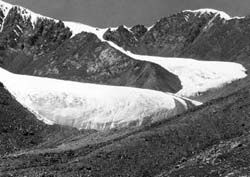
Based on their continuous on-site mass balance observation, researchers from the Cold & Arid Regions Environmental & Engineering Research Institute, a CAS research arm in Lanzhou, capital of northwest China's Gansu Province, found that the drastic process of thawing is occurring at the Glacier No.1 in the source region of the Urumqi River in the Xinjiang Uygur Autonomous Region.
Their research reveals that since the mid-1990s, the vicinity's temperature hike has brought in the most stunning change to the glacier ever recorded in the area. During the 45 years from 1958 to 2003, its thickness has reduced by some 11 meters, totaling 18.38 million cubic meters in aggregate volume of ice losses. During the 42 years from 1962 to 2004, its total area shrunk by 0.242 square kilometers, accounting for 12.4% of the glacier's area, presenting an accelerated momentum of the shrinkage.
During the same period, the eastern end of the glacier saw a retreat up to 175.2m and the same figure for the western end was 197.6m, showing a retarded tempo in the glacier's surface movement. Since 1986, the depth of its annual run-off in average has doubled, leading to the appearance of a 5m-high icy crag exposed to a massive melting process at the top of the glacier's eastern branch. As a result, a pool of about 30 square meters has been formed from the melting water. Scientists conclude that the glacier's mass balance is less than the amount thawing away, leading to the incessant retreat of the glacier.
Because of the growing trend of the current warming-up worldwide, the glacier thaws in a more and more intensified way, remarkably affecting the ice-forming layers and cross-section of the ice sheet. In such a circumstance, the borderlines of different layers in the glacier become blurred. Also, the research discovers that the thawing trend is expanding since 1996 and the elevation of the limits of ice-forming layers is lifting up higher and higher. The obtained data show the end of the glacier's icy lobe reaches 4074m in elevation, an uplift of 74m over the responding figure recorded in 1962. With the ice-forming layers becoming more and more dwindling in their area, the glacier now is speeding up its thawing tempo, the scientists say.







